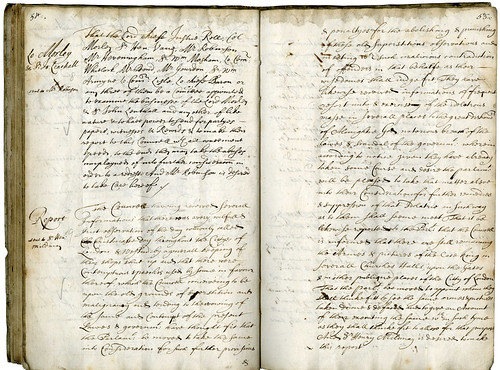First off, Happy Holidays from Risky Carolyn!
Here’s something I didn’t know, Oliver Cromwell banned Christmas.
Transcript
Report sent to S[i]r Hen[ry] Mildmay
The Councell haveing received severall Informations that there was avery wilfull & strict observation of the day com[m]only called Christmasse day throughout the Cittyes of London & Westm[inster] by agenerall keeping of their shops shut up and that there were Contemptuous speeches used by some in favour thereof, which the Councell conceiveing to be upon the old grounds of superstition and malignancy and tending to the avowing of the same and Contempt of the present Lawes and governm[en]t have thought fit that the Parlam[en]t be moved to take the same into Consideration for such further provisions and penaltyes for the abolishing & punishing of those old superstitions observations and meeting w[i]th such malicious contradiction of offenders in that behalfe as their wisedomes shall iudge fit, They have likewise received informations of frequent resort unto and exerciseing of the idolatrous masse in severall places to the great dishono[u]r of Almightie God, notorious breach of the lawes and scandal of the governm[en]t wherein according to notice given they have already taken some Course and desire the parlam[en]t will be pleased to take that matter alsoe into their Consideration for further remedies & suppression of that Idolatrie in such way as to them shall seeme meet.That it be likewise reported to the Parl[amen]t that the Councell is informed that there are still remaining the Armes and pictures of the late King in severall Churches Halls, upon the Gates and in other publique places of the Citty of London
That the parl[amen]t bee moved to appoint whom they shall thinke fitt to see the same armes & pictures taken downe and defaced and to give an Account of their executing the same w[i]thin such tyme as they shall thinke fit to allow for that purpose
And S[i]r Henry Mildmay is desired to make this report
Celebrate as you see fit. Christmas, I heard the other day, is celebrated by 80% of Americans regardless of any religious beliefs about God or men in red suits. In other words, a number of us are celebrating a very pagan Christmas. To me, that’s a fine meaning of Christmas. Buying presents for people you love, doing nice things, saying Happy Holidays! or Merry Christmas! and meaning it. And eating cookies and other goodies.
Doorknob News
In doorknob news, the Doorknob man did email me back and he pointed me in the direction of some astonishingly fantastic resources, including dates and pictures.
Doorknobs as we know them (the turning kind) did NOT exist in the Regency. A latch type door, which was the most common sort, could (and often did!) have what looked pretty much exactly like a doorknob. Only it was push/pull to open/close the door, not a knob that turned.
This means my hero and heroine can, indeed, have a door hardware malfunction. Is that awesome or what?
Traditions
Speaking of Christmas and traditions that Oliver Cromwell failed to stamp out, we have a fairly recent tradition in our family, which is the gift exchange involving EVERYONE and is in addition to any other gifting that may go on, in which everyone buys a gift for no more than $15, and then we do that gift stealing round robin thing. It’s much fun and involves a great deal of plotting and trading and backroom deals, as well as a great deal of thought about what gift to bring. The gifts are anonymous, of course.
Afterward there is often spirited trading.
Do you have a family tradition? Share in the comments.






















